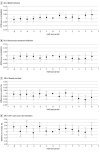Emergency Department Peer Support Program and Patient Outcomes After Opioid Overdose
- PMID: 38526490
- PMCID: PMC10964115
- DOI: 10.1001/jamanetworkopen.2024.3614
Emergency Department Peer Support Program and Patient Outcomes After Opioid Overdose
Abstract
Importance: Patients treated in emergency departments (EDs) for opioid overdose often need drug treatment yet are rarely linked to services after discharge. Emergency department-based peer support is a promising approach for promoting treatment linkage, but evidence of its effectiveness is lacking.
Objective: To examine the association of the Opioid Overdose Recovery Program (OORP), an ED peer recovery support service, with postdischarge addiction treatment initiation, repeat overdose, and acute care utilization.
Design, setting, and participants: This intention-to-treat retrospective cohort study used 2014 to 2020 New Jersey Medicaid data for Medicaid enrollees aged 18 to 64 years who were treated for nonfatal opioid overdose from January 2015 to June 2020 at 70 New Jersey acute care hospitals. Data were analyzed from August 2022 to November 2023.
Exposure: Hospital OORP implementation.
Main outcomes and measures: The primary outcome was medication for opioid use disorder (MOUD) initiation within 60 days of discharge. Secondary outcomes included psychosocial treatment initiation, medically treated drug overdoses, and all-cause acute care visits after discharge. An event study design was used to compare 180-day outcomes between patients treated in OORP hospitals and those treated in non-OORP hospitals. Analyses adjusted for patient demographics, comorbidities, and prior service use and for community-level sociodemographics and drug treatment access.
Results: A total of 12 046 individuals were included in the study (62.0% male). Preimplementation outcome trends were similar for patients treated in OORP and non-OORP hospitals. Implementation of the OORP was associated with an increase of 0.034 (95% CI, 0.004-0.064) in the probability of 60-day MOUD initiation in the half-year after implementation, representing a 45% increase above the preimplementation mean probability of 0.075 (95% CI, 0.066-0.084). Program implementation was associated with fewer repeat medically treated overdoses 4 half-years (-0.086; 95% CI, -0.154 to -0.018) and 5 half-years (-0.106; 95% CI, -0.184 to -0.028) after implementation. Results differed slightly depending on the reference period used, and hospital-specific models showed substantial heterogeneity in program outcomes across facilities.
Conclusions and relevance: In this cohort study of patients treated for opioid overdose, OORP implementation was associated with an increase in MOUD initiation and a decrease in repeat medically treated overdoses. The large variation in outcomes across hospitals suggests that treatment effects were heterogeneous and may depend on factors such as implementation success, program embeddedness, and availability of other hospital- and community-based OUD services.
Conflict of interest statement
Figures




References
-
- National Center for Health Statistics, Centers for Disease Control and Prevention. US overdose deaths in 2021 increased half as much as in 2020—but are still up 15%. May 11, 2022. Accessed December 11, 2022. https://www.cdc.gov/nchs/pressroom/nchs_press_releases/2022/202205.htm
-
- Centers for Disease Control and Prevention . DOSE dashboard: nonfatal overdose syndromic surveillance data. January 3, 2023. Accessed January 9, 2023. https://www.cdc.gov/drugoverdose/nonfatal/dashboard/index.html
-
- National EMS Information System, National Highway Traffic Safety Administration. Nonfatal opioid overdose surveillance dashboard. January 7, 2023. Accessed January 9, 2023. https://nemsis.org/nonfatal-drug-overdose-surveillance-dashboard/
Publication types
MeSH terms
Grants and funding
LinkOut - more resources
Full Text Sources
Medical

